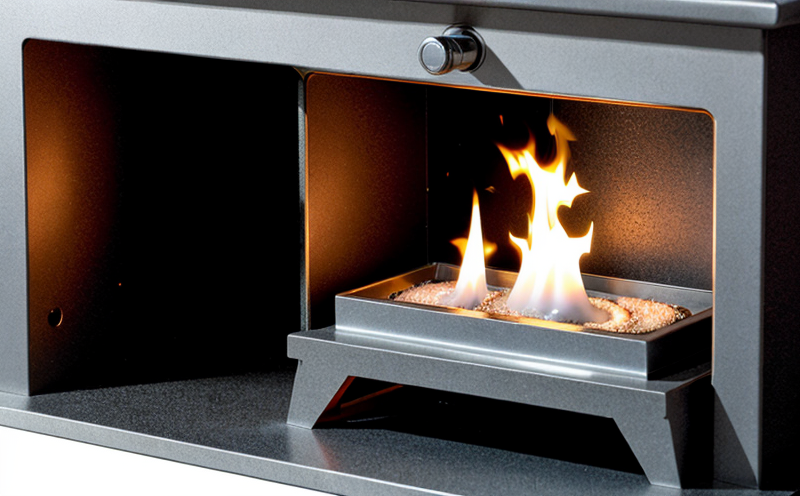Ignitability Testing of Industrial Safety Panels
The ignitability testing of industrial safety panels is a critical process that ensures the fire safety integrity and compliance with regulations. This testing evaluates how easily a material can ignite, burn, or spread flames under specific conditions. In industries where fire safety is paramount, such as construction, manufacturing, and transportation, this test plays an indispensable role in safeguarding lives and property.
The procedure typically involves exposing the industrial safety panels to controlled heat sources and measuring the flame spread rate and time-to-ignition. This helps determine if the material meets the specified fire resistance requirements of relevant standards like ASTM E84 or ISO 6947, which are widely accepted in North America and Europe.
The testing apparatus used for ignitability includes a specialized chamber designed to simulate real-world conditions where these panels might be exposed to flames. The specimen is carefully prepared according to standard protocols, ensuring that the test results accurately reflect the material's performance under actual use scenarios. This preparation often involves cutting the panel into standardized dimensions and ensuring it is free from defects.
The testing process itself involves subjecting the specimen to a specified heat source for a defined duration while monitoring various parameters such as flame spread distance, peak heat release rate, and smoke generation. The results are then analyzed to determine if the material falls within acceptable limits set by regulatory bodies. Compliance with these standards is crucial because it ensures that the materials used in construction or other applications do not contribute significantly to fire hazards.
Furthermore, this test also helps manufacturers identify potential weaknesses in their products early on during development stages. By detecting issues before full-scale production begins, companies can make necessary adjustments and improvements, thereby enhancing overall product quality and safety standards.
In conclusion, ignitability testing of industrial safety panels is a vital step towards ensuring fire safety compliance and preventing accidents that could otherwise occur due to non-compliant materials being used in critical environments. It provides valuable insights into material behavior during fires, helping stakeholders make informed decisions about selecting appropriate products for their projects.
Industry Applications
The ignitability testing of industrial safety panels finds application across various sectors including construction, automotive manufacturing, aviation, and maritime industries. In construction, these tests ensure that building materials are suitable for use in high-risk areas such as commercial offices or residential complexes where fire incidents could have severe consequences.
For the automotive industry, ignitability testing is essential for ensuring that interior trimmings meet stringent safety standards set by organizations like FMVSS (Federal Motor Vehicle Safety Standards) and ECE R119. Similarly, in aviation and maritime sectors, compliance with ignitability tests ensures that cabin interiors are non-flammable, reducing the risk of fires during emergencies.
These industries rely heavily on rigorous quality control processes to maintain high safety standards. Ignitability testing serves as one such crucial component by verifying whether materials used comply with necessary regulations and guidelines. By adhering strictly to these tests, manufacturers can ensure that their products not only meet but exceed expectations in terms of fire resistance.
Why Choose This Test
The decision to conduct ignitability testing for industrial safety panels is driven by several key factors including regulatory compliance and enhanced product performance. Regulatory bodies such as the National Fire Protection Association (NFPA) and Underwriters Laboratories (UL) mandate that certain materials used in specific applications must pass rigorous ignitability tests.
Compliance with these regulations ensures not only legal adherence but also contributes to public safety by minimizing potential hazards associated with non-compliant products. For manufacturers, passing such tests demonstrates commitment to quality and reliability, which enhances brand reputation and customer trust.
In addition to regulatory compliance, ignitability testing offers significant benefits in terms of improved product performance. It helps identify weaknesses or flaws in materials early on during the development phase, allowing for timely corrections before large-scale production begins. This proactive approach leads to better overall product quality and reliability, ultimately resulting in safer end products.
Moreover, conducting ignitability tests can provide valuable data that informs ongoing research and development efforts. Manufacturers can leverage this information to continuously improve their materials and processes, staying ahead of industry trends and advancements.
In summary, choosing to undergo ignitability testing for industrial safety panels aligns with both regulatory requirements and the pursuit of superior product quality. It is an investment in public safety and brand reputation that yields long-term benefits for all stakeholders involved.
Use Cases and Application Examples
In construction projects, ignitability testing plays a crucial role in selecting appropriate materials for use in fire-resistant walls and partitions. This test ensures that the chosen panels can withstand exposure to flames without spreading them too rapidly or releasing excessive amounts of smoke, which could compromise safety during an emergency.
For instance, when constructing office buildings or hospitals, architects often specify the use of Class A-rated materials based on their performance in ignitability tests. These materials are designed to self-extinguish quickly after being exposed to fire, providing additional protection against spreading flames and minimizing damage.
The automotive industry also uses this test extensively for interior components such as seat covers and door panels. By ensuring that these items meet strict ignitability standards, manufacturers can enhance vehicle safety during accidents or fires within the cabin area. For example, some car models are equipped with advanced fire suppression systems that work more effectively when paired with non-flammable interiors.
In aviation and maritime applications, ignitability testing is critical for maintaining high levels of passenger comfort while adhering to strict safety protocols. Cabin furnishings must be made from materials that do not catch fire easily or produce large quantities of toxic gases upon combustion. This ensures a safer environment for travelers during emergencies such as engine failures or structural damage.
Furthermore, this testing extends beyond just identifying suitable materials; it also helps in designing innovative solutions tailored to specific needs within each industry. For example, some manufacturers have developed specialized coatings that provide enhanced fire resistance properties without compromising aesthetics or functionality.





